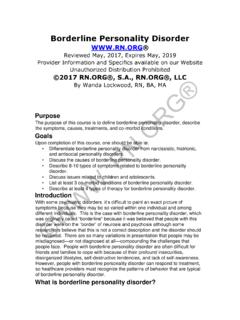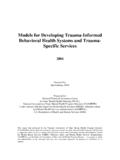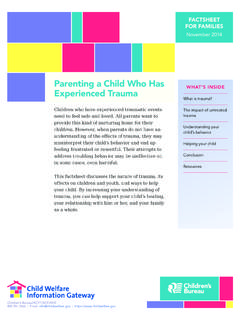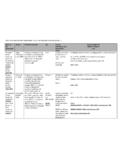Transcription of Dyadic Developmental Psychotherapy: Arthur Becker …
1 Dyadic Developmental psychotherapy : An Evidence-Based and Effective Treatment for trauma and Disorders of Attachment Arthur Becker -Weidman, Director, Center For Family Development INTRODUCTION The purpose of this article is to outline several of the elements of Dyadic Developmental psychotherapy and demonstrate the evidence base for those components. While there have been a two outcome studies using control groups that demonstrated the overall effectiveness of Dyadic Developmental psychotherapy , the treatment is an integration of several approaches, methods, and techniques that each have strong evidence and empirical bases. The two outcome studies, coupled with the evidence base for the components of Dyadic Developmental psychotherapy , provide support for the efficacy of this model of treatment. A recent meta-analysis (Craven & Lee, 2006), based on the partial and preliminary results of one study in 2004, determined that Dyadic Developmental psychotherapy is, supported and acceptable ( ).
2 There has been a substantial amount of confusion and controversary about the diagnosis and treatment of Reactive Attachment Disorder (O Connor & Zeanah, 2003). Attachment therapy, holding therapy, and other terms are often used interchangeably, as are RAD or Reactive Attachment Disorder, Attachment Disorder, and related terms, which only adds to the confusion. Dyadic Developmental psychotherapy is not a holding therapy as defined by O Connor and Zeanah (2003). They describe holding therapy as being based on rage reduction techniques and that, the holding approach would be viewed as intrusive and therefore non-sensitive and counter therapeutic (Italics added, p. 236). Dyadic Developmental psychotherapy has as its core, or central Dyadic Developmental psychotherapy Page 2 of 18 therapeutic mechanism for treatment success, the maintenance of a contingent, collaborative, sensitive, reflective, and affectively attuned relationship between therapist and child, between caregiver and child, and between therapist and caregiver.
3 Dyadic Developmental psychotherapy focuses on and relies upon the intersubjective sharing and joint development and organization of emotional experience. Children who have experienced chronic maltreatment and resulting complex trauma are at significant risk for a variety of other behavioral, neuropsychological, cognitive, emotional, interpersonal, and psychobiological disorders (Cook, A., et. al., 2005; van der Kolk, B., 2005). Many children with histories of maltreatment are violent (Robins, 1978) and aggressive (Prino & Pyrot, 1994) and as adults are at risk of developing a variety of psychological problems (Schreiber & Lyddon, 1998) and personality disorders, including antisocial personality disorder (Finzi, Cohen, Sapir, & Weizman, 2000), narcissistic personality disorder, borderline personality disorder, and psychopathic personality disorder (Dozier, Stovall, & Albus, 1999). Neglected children are at risk of social withdrawal, social rejection, and pervasive feelings of incompetence (Finzi et al.)
4 , 2000). Children who have histories of abuse and neglect are at significant risk of developing Post Traumatic Stress Disorder as adults (Allan, 2001; Andrews, Varewin, Rose, & Kirk, 2000). Children who have been sexually abused are at significant risk of developing anxiety disorders ( times the average), major depressive disorders ( times average), alcohol abuse ( times average), drug abuse ( times average), and antisocial behavior ( times average) (MacMillian, 2001). The effective treatment of such children is a public health concern (Walker, Goodwin, & Warren, 1992). Children and adolescents with complex trauma require an approach to treatment that focuses on several dimensions of impairment (Cook, et. al., 2005). Chronic Dyadic Developmental psychotherapy Page 3 of 18 maltreatment and the resulting complex trauma cause impairment in a variety of vital domains including the following: Self-regulation Interpersonal relating including the capacity to trust and secure comfort Attachment Biology, resulting in somatization Affect regulation Increased use of defensive mechanisms, such as dissociation Behavioral control Cognitive functions, including the regulation of attention, interests, and other executive functions.
5 Self-concept. Dyadic Developmental psychotherapy addresses these domains of impairment. Dyadic Developmental psychotherapy shares many important elements with optimal, sound social casework and clinical practice. For example, attention to the dignity of the client, respect for the client's experiences, and starting where the client is, are all time-honored principles of clinical practice and all are also central elements of Dyadic Developmental psychotherapy . What distinguishes Dyadic Developmental psychotherapy from other methods of clinical work with children, such as Cognitive Behavioral Therapy, is the strong emphasis on maintaining an intersubjective relationship with the child, deep acceptance of the child's affect and experience, non-judgmental curiosity about the meaning the child has given to the events of the child s life, and greater emphasis on experience and process rather than on verbalization and content. Dyadic Developmental psychotherapy requires a greater use of self in both the here-and-now experience of the child as well as in the expression of that experience to Dyadic Developmental psychotherapy Page 4 of 18 the child, than, for example, does Cognitive-Behavioral psychotherapy , behavioral approaches, or strategic or structural family therapy interventions.
6 Dyadic DEVEOPMENTAL psychotherapy Dyadic Developmental psychotherapy is a treatment developed by Daniel Hughes (Hughes, 2004, 2005, 2006). A more complete description of the treatment approach including specific techniques and methods along with case examples can be found in Becker -Weidman & Shell (2005). Its basic principles are described by Hughes (2004, 2005, 2006) and Becker -Weidman & Shell (2005) and summarized as follows. 1. A focus on both the caregivers and therapists own attachment strategies. Previous research (Dozier, 2001, Tyrell 1999) has shown the importance of the caregivers and therapists state of mind for the success of interventions. 2. The therapist and caregiver provide the intersubjective experiences for the child that are seldom present in situations of abuse and neglect. These intersubjective experiences are characterized by shared affect (attunement), joint focus of awareness and attention, and complementary intentions. Intersubjective experiences are the primary means whereby the infant and young child learn about self, other, and the world (Trevarthen, 2001).
7 Intrafamilial trauma will significantly disrupt the development of intersubjectivity and increase the risk that the child will be unable to create a coherent meaning for many events and especially traumatic ones. Facilitating intersubjective experiences between the therapist and caregiver and the child enables the therapist and caregiver to co-regulate emerging affect that is associated with traumatic or other stressful events, while at the same time, co-create new meanings of these events. When the therapist and caregiver manifest a clear intention to provide such Dyadic Developmental psychotherapy Page 5 of 18 intersubjective experiences, when their attention is focused and non-judgmental, and when their affect is regulated, the child often, for the first time, has the opportunity to organize a coherent experience around the traumatic event. 3. In some situations the caregiver s own attachment style may create barriers to the caregiver s ability to create a positive shared intersubjective experience with the child.
8 In these instances, it is important for the therapist to provide intersubjective experiences for the caregiver that are positive, supportive, and, therefore, healing. When these issues are true as well for the therapist, the therapist needs to address the difficulty in supervision or therapy for himself or herself. 4. Use of PACE and PLACE. These acronyms describe the attitude of the therapist and caregiver. PACE refers to the therapist setting a healing pace to therapy by being playful, accepting, curious, and empathic. Through PACE the therapist is able to both generate and regulate though empathy (and playfulness when appropriate) the emerging affect that is associated with events being explored. The therapist is also able to facilitate an open, reflective attitude to reorganizing the experience of these events through her accepting and curious stance. PLACE refers to the parent creating a healing environment by being playful, loving accepting, curious, and empathic. These ideas are described more fully in Becker -Weidman & Shell (2005).
9 5. The inevitable misattunements and conflicts that arise in interpersonal relationships are directly addressed and then repaired through the ongoing qualities of the relationship (PACE). The need for repair is especially important since the themes often being explored are often characterized by shame and Dyadic Developmental psychotherapy Page 6 of 18 fear. Repair helps with both affect regulation and directly challenges the distorted beliefs of being alone in handling affects. 6. Caregivers use attachment-facilitating interventions that meet the Developmental needs and state of the child. These include interventions that facilitate safety, emotional communication, reflection, conflict resolution skills, and the ability to both seek and receive comfort and guidance. The effective application of these supportive and emotionally-responsive and sensitive interventions does require that the caregiver have a reasonably well developed reflective function and ability to engage in the intersubjective sharing of affect and meaning in a relatively undistorted manner.
10 The primary approach is to create a secure base in treatment (using techniques that fit with maintaining a healing PACE (Playful, Accepting, Curious, and Empathic) and at home using principles that provide safe structure and a healing PLACE (Playful, Loving, Acceptance, Curious, and Empathic). Developing and sustaining an attuned relationship within which contingent collaborative communication occurs helps the child heal. Healing is facilitated by the co-regulation of affect, the co-creation of meaning, and the emerging development of greater reflective capacities (Fonagy, Gergely, Jurist, & Target, 2002) Coercive interventions (that have been attributed to other therapeutic approaches for children with trauma /attachment problems) such as rib-stimulation, holding-restraining a child in anger or to provoke an emotional response, shaming a child, using fear to elicit compliance, and interventions based on power/control and submission are never used and are inconsistent with a treatment rooted in attachment theory and current knowledge about the neurobiology of interpersonal behavior.)









